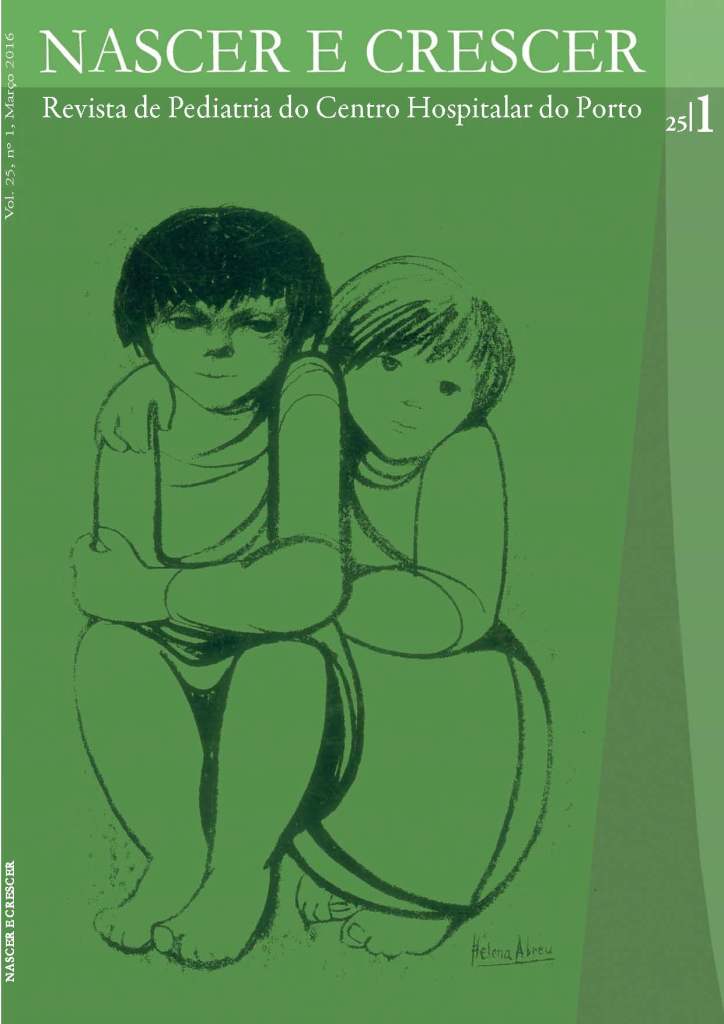Benign transient HIPERPHOSPHATASEMIA of infancy and childhood and CAMPYLOBACTER JEJUNI infection
DOI:
https://doi.org/10.25753/BirthGrowthMJ.v25.i1.8827Keywords:
Campylobacter jejuni, alkaline phosphatase, transient hyperphosphatasemia, infectionAbstract
Introduction: Benign Transient Hyperphosphatasemia (BTH) is characterised by transient elevation of serum alkaline phosphatase (ALP) in the absence of liver or bone disease. It has been associated to several entities, namely infections.
Case report: We describe the case of a healthy two-year-old child with intermittent episodes of fever, abdominal pain, vomiting and soft stool since two months ago, with no relevant changes on physical examination. The exams revealed elevated ALP (2474 U/L), with normal liver function, calcium and phosphorus. The stool culture was positive for Campylobacter jejuni. Clinical condition was resolved after antibiotic therapy with azithromycin. Six months later serum ALP values were normal.
Conclusion: The age of presentation, the absence of underlying disease and subsequent normalization of ALP allow the diagnosis of BTH. It isn´t possible, according to the available literature, to guarantee if the infection was the cause of BTH or if it was the reason to perform the analytical study.
Downloads
References
Gualco MD et al. Transient benign hyperphosphatasemia. Journal of Pediatric Gastroenterology and Nutrition 2013;57:167-71.
Huh SY. et al. Prevalence of transient hyperphosphatasemia among healthy infants and toddlers. Pediatrics 2009;124:703-9.
Kraut J. Isoenzime studies in transient hyperphosphatasemia of infancy. AJDC 1985;139:736-40.
Tolaymat N, Melo MCN. Benign Transient hyperphosphatasemia of infancy and childhood. South Med J 2000;93.
Pace A, Osinde M. Hiperfosfatasemia transitoria benigna de la infancia. Una aproximación racional. Arch. Argent. Pediatr; 1999; 97: 383.
Alves C, Arruti R. “Hiperfosfatasemia Transitória Benigna da Infância”. Acta Ortopédica Brasileira; 2008; 17: 55-7.
Nuñez MA, Menendez A, Diez M.“Hiperfosfatasemia transitoria de la infancia. Nueve casos y revisión de las aportaciones españolas”.Anales Españoles de Pediatria; 1997; 46: 503-7.
Otero JL et al. Elevated alkaline phosphatase in children: an algorithm to determine when a “wait and see” approach is optimal. Clinical Medicine Insights: pediatrics 2011;5:15-8.
Ranchin B, Villard F, André JL, Canterino I, Said MH, Boisson RC, et al. Transient hyperphosphatasemia after organ transplantation in children. Pediatr Transplant. 2002;6:308-12.
Gennery AR, Peaston RT, Hasan A. Benign transient hyperphosphatasemia of infancy and early childhood following cardiac transplantation. Pediatr Transplant. 1998;2:197-9.
Massey GV, Dunn NL, Heckel JL, Chan JC, Russell EC. Benign transient hyperphosphatasemia in children with leukemia and lymphoma. Clin Pediatr (Phila).1996;35: 501-4.
Kutilek S, Cervickova B, Bebova P, Kmonickova M, Nemec V. Normal bone turnover in transient hyperphosphatasemia. J Clin Res Pediatr Endocrinol 2012;4:154-6.
Marcos JMG, Árias MM, Olavarría FE, Sierra AA. Hiperfosfatasemia transitória benigna: aportacion de 20 nuevos casos. An Esp Pediatr 1996;44:112-6.
Downloads
Published
How to Cite
Issue
Section
License
Copyright and Authors' Rights
All articles published in Nascer e Crescer - Birth and Growth Medical Journal are Open Access and comply with the requirements of funding agencies or academic institutions. For use by third parties, Nascer e Crescer - Birth and Growth Medical Journal adheres to the terms of the Creative Commons License "Attribution - Non-Commercial Use (CC-BY-NC)".
It is the author's responsibility to obtain permission to reproduce figures, tables, etc. from other publications.
Authors must submit a Conflict of Interest statement and an Authorship Form with the submission of the article. An e-mail will be sent to the corresponding author confirming receipt of the manuscript.
Authors are permitted to make their articles available in repositories at their home institutions, provided that they always indicate where the articles were published and adhere to the terms of the Creative Commons license.


